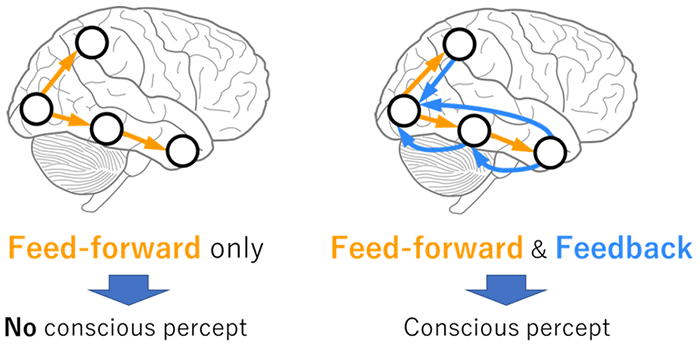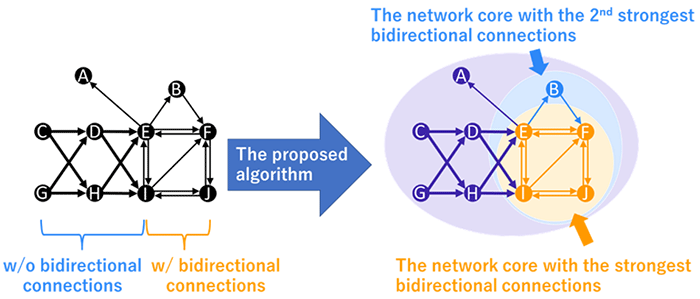In a study published in Cerebral Cortex, researchers at the University of Tokyo, Jun Kitazono, a project researcher, Masafumi Oizumi, an associate professor, and Yuma Aoki, a graduate student, analyzed the neural network in the mouse brain and showed that the parts of the network with particularly strong bidirectional connections consist of brain regions considered important for consciousness. This suggests that the bidirectionality of connections may be a key to identifying the place of consciousness in the brain.
In the brain, brain regions form a complex network to realize various functions and phenomena. One of the things supposed to be realized by the complex network is our subjective experience, consciousness. However, it remains unclear which part of the network is responsible for consciousness.
In identifying the place of consciousness in the brain network, a key consideration is the bidirectionality of connections between brain regions. Previous research has shown that both feed-forward and feedback signaling, i.e., bidirectional signaling is necessary for consciousness. This suggests that in the subnetwork (1) where consciousness resides, the brain regions should be bidirectionally connected. Based on this idea, evaluating which subnetworks are bidirectionally connected and the strength of these bidirectional connections is an important step in identifying the subnetworks essential to consciousness. However, identifying such subnetworks has been difficult because the brain network has a complex structure, comprising numerous regions.
For this study, the researchers proposed an algorithm that can rapidly identify subnetworks with strong bidirectional connections, so to speak, cores (2) of the network. Then, they applied the algorithm to a mouse connectome. The mouse connectome is a detailed map of the connections among about 400 regions throughout the brain. They found that the cores with particularly strong bidirectional connections consist of regions that previous studies suggest are important for consciousness (e.g., regions in the cerebral cortex and the thalamus, and the claustrum), while not including regions suggested not to contribute directly to consciousness (e.g., the cerebellum). These results support the idea that bidirectionality in the brain network is a key to identifying the place of consciousness.
If future research can elucidate the relationship between bidirectionality of brain networks and consciousness, it will hopefully help to better understand and treat disorders such as disorders of consciousness.
This research was conducted under the JST Strategic Basic Research Programs.
CREST: Research Areas “Development and application of intelligent measurement-analysis methods through coalition between measurement technologies and informatics” and “Intelligent information processing systems creating co-experience knowledge and wisdom with human-machine harmonious collaboration”
ACT-X: Research Area “AI powered research innovation/creation”
<Glossary>
(1) Subnetwork
A part of a network.
(2) Core
A subnetwork in which nodes are particularly strongly interconnected. In previous studies, various definitions of core have been proposed, depending on how the strength of the connection is defined. In this study, the researchers newly defined a "core" that has taken into account the bidirectionality of connections, and also developed an algorithm able to rapidly identify the cores.
-

Figure1: Importance of bidirectionality for consciousness It has been suggested that bidirectionality of signal propagation in the brain is important for conscious experience. For example, previous studies examining visual perception have shown that conscious perception does not arise when there is only feed-forward signaling, whereas it arises when there is feedback as well as feed-forward signaling. ©2022 Jun Kitazono
-

Figure2: Schematic of extraction of network cores with strong bidirectional connections using the proposed algorithm The proposed algorithm can decompose the entire network hierarchically, into the core with the strongest bidirectional connections, the core with the second strongest, and so on down the line. ©2022 Jun Kitazono
Program Information
- JST CREST
- Research Area “Development and application of intelligent measurement-analysis methods through coalition between measurement technologies and informatics”
- Research Theme “Development of conscious meter based on the causal structure of information network and high dimensional measurement of brain activity”
- JST ACT-X
- Research Area “AI powered research innovation/creation”
- Research Theme “Extension of integrated information theory based on submodularity and its applications to neuroscience”
- JST CREST
- Research Area “Intelligent information processing systems creating co-experience knowledge and wisdom with human-machine harmonious collaboration”
- Research Theme “Construction of artificial consciousness and its application in real life situations based upon axiomatic neurocomputational theories and constructivistic engineering approaches”
Journal Information
Jun Kitazono, Yuma Aoki and Masafumi Oizumi. “Bidirectionally connected cores in a mouse connectome: towards extracting the brain subnetworks essential for consciousness”, Cerebral Cortex. Published online July 21, 2022, doi: 10.1093/cercor/bhac143
Contact
-
[About Research]
Jun Kitazono
Project Researcher, Graduate School of Arts and Sciences, The University of Tokyo
E-mail: c-kitazonog.ecc.u-tokyo.ac.jp
Masafumi Oizumi
Associate Professor, Graduate School of Arts and Sciences, The University of Tokyo
E-mail: c-oizumig.ecc.u-tokyo.ac.jp
-
[About Program]
Yuko Shimabayashi, Sachiko Maeda
Department of Strategic Basic Research, JST
E-mail: crestjst.go.jp
Takeshi Usami
Department of Strategic Basic Research, JST
E-mail: act-xjst.go.jp
